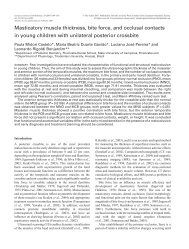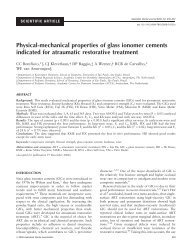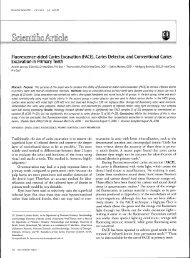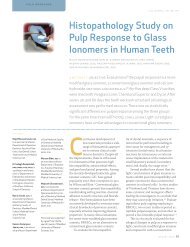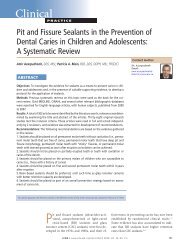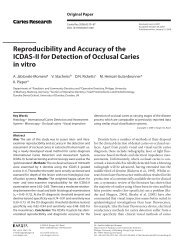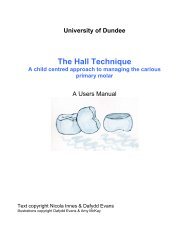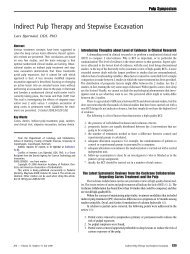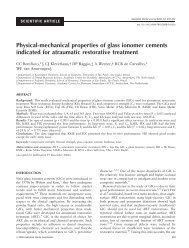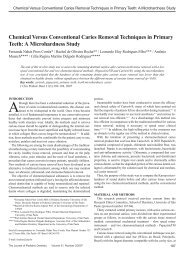Quintessence Journals - Sandra Kalil Bussadori
Quintessence Journals - Sandra Kalil Bussadori
Quintessence Journals - Sandra Kalil Bussadori
You also want an ePaper? Increase the reach of your titles
YUMPU automatically turns print PDFs into web optimized ePapers that Google loves.
Copyright<br />
study, no statistically significant influence of the restorative<br />
material was found. This finding agrees with prior findings<br />
that even a thin layer of residual dentin may protect<br />
the pulp against both material and bonding system toxicity,<br />
2,20 so that different restorative materials or adhesives<br />
will not have a significant influence on the pulp tissue. 24<br />
Cox 7 also showed the restorative materials to have a minimal<br />
influence on postoperative pulp reactions. In contrast<br />
to these findings, a recent study by Whitworth et al 35 observed<br />
a correlation between restorative materials and<br />
pulp breakdown only in the deep cavities and cavities with<br />
pulp exposure. This finding may be explained with previous<br />
investigations which showed that odontoblasts are already<br />
injured by cavity preparations with a depth close to or into<br />
the pulp tissue, 11,17 which may lead to pulp inflammation<br />
and pulp breakdown.<br />
We suggest that the layer formed by the adhesive systems<br />
acts as a barrier to filling material contents reaching<br />
the pulp. Similar to our finding that the materials used<br />
here had no influence on the pulp vitality, Nayyar et al 24<br />
also observed no difference in the pulp response between<br />
a self-etching adhesive and an etch-and-rinse adhesive.<br />
CONCLUSION<br />
The results of the present study showed that neither the<br />
thickness of the remaining dentin, the use of calcium hydroxide<br />
liner, nor the adhesive and restorative system<br />
used in the study have an impact on the incidence of postoperative<br />
pain.<br />
REFERENCES<br />
1. Akimoto N, Momoi Y, Kohno A, Suzuki S, Otsuki M, Suzuki S, Cox CF. Biocompatibility<br />
of Clearfil Liner Bond 2 and Clearfil AP-X system on nonexposed<br />
and exposed primate teeth. <strong>Quintessence</strong> Int 1998;29:177-188.<br />
2. Bergenholtz G. Evidence for bacterial causation of adverse pulpal responses<br />
in resin-based dental restorations. Crit Rev Oral Biol Med<br />
2000;11:467-480.<br />
3. Brännström M, Linden LA, Astrom A. The hydrodynamics of the dental<br />
tubule and of pulp fluid. A discussion of its significance in relation to dentinal<br />
sensitivity. Caries Res 1967;1:310-317.<br />
4. Brännström M, Nordenvall KJ. Bacterial penetration, pulpal reaction and<br />
the inner surface of Concise enamel bond. Composite fillings in etched<br />
and unetched cavities. J Dent Res 1978;57:3-10.<br />
5. Briso ALF, Mestrener SR, Delicio G, Sundfeld RH, Bedran-Russo AK. Clinical<br />
assessment of postoperative sensitivity in posterior composite restorations.<br />
Oper Dent 2007;32:421-426.<br />
6. Camps J, Dejou J, Remusat M, About I. Factors influencing pulpal response<br />
to cavity restorations. Dent Mater 2000;16:432-440.<br />
7. Cox CF. Effects of adhesive resins and various dental cements on the pulp.<br />
Oper Dent 1992;(suppl 5):165-176.<br />
8. Cox CF. Evaluation and treatment of bacterial microleakage. Am J Dent<br />
1994;7:293-295.<br />
9. Cox CF, Felton D, Bergenholtz G. Histopathological response of infected<br />
cavities treated with Gluma and Scotchbond dentin bonding agents. Am J<br />
Dent 1988;1(special issue):189-194.<br />
10 . Cox CF, Hafez AA, Akimoto N, Otsuki M, Suzuki S, Tarim B. Biocompatibility<br />
of primer, adhesive and resin composite systems on non-exposed and exposed<br />
pulps of non-human primate teeth. Am J Dent 1998;11(special<br />
issue):S55-63.<br />
11. Darvell BW. Effect of dentine thickness on pulpal changes beneath restorative<br />
materials. Aust Dent J 1981;26:80-81.<br />
12. Gente M. Begrenzung der Präparationstiefe durch elektrische Widerstandsmessungen.<br />
Dtsch Zahnarztl Z 1995;50:658-660.<br />
Not for Publication<br />
Wegehaupt et al<br />
<strong>Quintessence</strong><br />
13. Gente M. Untersuchung zur Begrenzung der Präparationstiefe bei der Kronenpräparation<br />
durch elektrische Widerstandsmessung. Marburg, Germany:<br />
Thesis, 1992<br />
14. Gente M, Becker-Detert D. Studies on the specific electric resistance of the<br />
dentin of human teeth [in German]. Dtsch Zahnarztl Z 1991;46:803-806.<br />
15. Keyes PH. The infectious and transmissible nature of experimental dental<br />
caries. Findings and implications. Arch Oral Biol 1960;1:304-320.<br />
16. Koliniotou-Koumpia E, Papadimitriou S, Tziafas D. Pulpal responses after<br />
application of current adhesive systems to deep cavities. Clin Oral Investig<br />
2007;11:313-320.<br />
17. Lee SJ, Walton RE, Osborne JW. Pulp response to bases and cavity depths.<br />
Am J Dent 1992;5:64-68.<br />
18. Loguercio AD, Reis A, Hernandez PA, Macedo RP, Busato AL. 3-Year clinical<br />
evaluation of posterior packable composite resin restorations. J Oral Rehabil<br />
2006;33:144-151.<br />
19. Mjör IA, Ferrari M. Pulp-dentin biology in restorative dentistry. Part 6: Reactions<br />
to restorative materials, tooth-restoration interfaces, and adhesive<br />
techniques. <strong>Quintessence</strong> Int 2002;33:35-63.<br />
20. Murray PE, Hafez AA, Smith AJ, Cox CF. Bacterial microleakage and pulp inflammation<br />
associated with various restorative materials. Dent Mater<br />
2002;18:470-478.<br />
21. Murray PE, Smith AJ, Windsor LJ, Mjör IA. Remaining dentine thickness<br />
and human pulp responses. Int Endod J 2003;36:33-43.<br />
22. Murray PE, Stanley HR, Matthews JB, Sloan AJ, Smith AJ. Age-related odontometric<br />
changes of human teeth. Oral Surg Oral Med Oral Pathol Oral Radiol<br />
Endod 2002;93:474-482.<br />
23. Nakabayashi N. Importance of mini-dumbbell specimen to access tensile<br />
strength of restored dentine: historical background and the future perspective<br />
in dentistry. J Dent 2004;32:431-442.<br />
24. Nayyar S, Tewari S, Arora B. Comparison of human pulp response to totaletch<br />
and self-etch bonding agents. Oral Surg Oral Med Oral Pathol Oral Radiol<br />
Endod 2007;104:45-52.<br />
25. Orland FJ, Blayney JR, Harrison RW, Reyniers JA, Trexler PC, Ervin RF, Gordon<br />
HA, Wagner M. Experimental caries in germfree rats inoculated with<br />
enterococci. J Am Dent Assoc 1955;50:259-272.<br />
26. Pameijer CH, Stanley HR, Ecker G. Biocompatibility of a glass ionomer luting<br />
agent. 2. Crown cementation. Am J Dent 1991;4:134-141.<br />
27. Perry RD, Kugel G, Habib CM, McGarry P, Settembrini L. A two-year clinical<br />
evaluation of TPH for restoration of Class II carious lesions in permanent<br />
teeth. Gen Dent 1997;45:344-349.<br />
28. Polansky R, Reichhold C, Lorenzoni M. Die Topographie der Pulpa im<br />
Seitenzahnbereich nach Stufenpräparation für Vollkeramische Kronen.<br />
Eine experimentelle Untersuchung. Dtsch Zahnarztl Z 1998;53:643-647.<br />
29. Schmalz G, Hiller KA, Nunez LJ, Stoll J, Weis K. Permeability characteristics<br />
of bovine and human dentin under different pretreatment conditions. J<br />
Endod 2001;27:23-30.<br />
30. Snuggs HM, Cox CF, Powell CS, White KC. Pulpal healing and dentinal<br />
bridge formation in an acidic environment. <strong>Quintessence</strong> Int 1993;24:501-<br />
510.<br />
31. Stanley HR. Dental iatrogenesis. Int Dent J 1994;44:3-18.<br />
32. Tielemans S, Bergmans L, Duyck J, Naert I. Evaluation of a preparation<br />
depth controlling device: a pilot study. <strong>Quintessence</strong> Int 2007;38:135-142.<br />
33. Türkün LS, Aktener BO. Twenty-four-month clinical evaluation of different<br />
posterior composite resin materials. J Am Dent Assoc 2001;132:196-203.<br />
34. Wendt SLJ, Leinfelder KF. Clinical evaluation of a posterior resin composite:<br />
3-year results. Am J Dent 1994;7:207-211.<br />
35. Whitworth JM, Myers PM, Smith J, Walls AW, McCabe JF. Endodontic complications<br />
after plastic restorations in general practice. Int Endod J<br />
2005;38:409-416.<br />
36. Wiegand A, Caspar C, Becker K, Werner C, Attin T. In vitro cytotoxicity of different<br />
self-etching dental adhesive systems. Schweiz Monatsschr Zahnmed<br />
2006;116:614-621.<br />
37. Wisithphrom K, Murray PE, About I, Windsor LJ. Interactions between cavity<br />
preparation and restoration events and their effects on pulp vitality. Int J<br />
Periodontics Restorative Dent 2006;26:596-605.<br />
for<br />
Clinical relevance: Neither the thickness of the remaining<br />
dentin, the use of calcium hydroxide liner, or the adhesive<br />
and restorative systems have an impact on the<br />
incidence of postoperative pain.<br />
Not<br />
by<br />
Vol 11, No 2, 2009 141





